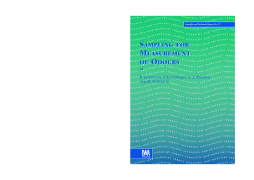
BOOK
Sampling for Measurement of Odours
Peter Gostelow | Philip J. Longhurst | Simon Parsons | Richard M. Stuetz
(2003)
Additional Information
Book Details
Abstract
Research into the sampling and measurement of odours has developed in a number of sectors, especially the agriculture, food and process industries, with knowledge from each sector being transferred to the wastewater and solid waste management sectors. Progressive developments in odour research have resulted in researchers re-tracing original research studies to understand the contribution and variability of differing sampling and measurement techniques. There are, however, very few reviews that compile earlier studies across each sector. This study looks at the information used to support current practices in odour sampling and measurement for impact reduction. Sampling for Measurement of Odours reviews European and other internationally available research studies to understand odour sampling and measurement practice in waste applications. The emphasis is placed on appropriate odour sampling and its relationship to differing measurement techniques. As recent developments in standardisation of odour measurement have reduced much of the variation and identified best practice in this area there is, at present, a far greater variation in sampling techniques with serious implications for the quality of samples obtained and their usefulness for assessing odour impact. The review considers the available information on uncontrolled area sources, identifies factors influencing sample losses or transformations and looks at information on the sources of variability identified through standardisation programmes. This need for this report was identified by the Odour Network, an EPSRC-sponsored discussion platform intended to promote multidisciplinary research in the areas of odour measurement, modelling and treatment. Scientific and Technical Report No.17
Table of Contents
| Section Title | Page | Action | Price |
|---|---|---|---|
| Contents | 6 | ||
| Preface | 8 | ||
| 1.0 Introduction | 11 | ||
| 2.0 Odour measurement | 13 | ||
| 2.1\tINTRODUCTON | 13 | ||
| 2.2 SENSORY MEASUREMENTS | 13 | ||
| 2.2.1 Odour parameters | 14 | ||
| 2.2.2 Sensory measurement techniques | 15 | ||
| 2.2.2.1 Threshold olfactometry | 16 | ||
| Olfactometer design | 18 | ||
| Test procedure | 18 | ||
| Pannelist sensitivity | 20 | ||
| Calculation of TON | 21 | ||
| 2.2.2.2 Standards for olfactometry | 21 | ||
| 2.3 ANALYTICAL MEASUREMENTS | 24 | ||
| 2.4 CHOICE OF ODOUR MEASUREMENT METHOD | 28 | ||
| 3.0 Source sampling | 31 | ||
| 3.1 INTRODUCTION | 31 | ||
| 3.2 SOURCE SAMPLING | 31 | ||
| 3.2.1 Point sources | 32 | ||
| 3.2.2 Volume sources | 32 | ||
| 3.2.3 Area sources | 32 | ||
| 3.2.3.1\tMicrometeorological methods | 33 | ||
| Flux profile methods | 33 | ||
| Integrated horizontal flux method | 35 | ||
| Theoretical profile shape method | 36 | ||
| Gaussian dispersion methods | 36 | ||
| 3.2.3.2 Hood methods | 37 | ||
| Static flux chambers | 41 | ||
| Dynamic flux chambers | 42 | ||
| Wind tunnels | 43 | ||
| 3.2.3.3 Choice of area source measurement method | 49 | ||
| 4.0 Sample collection and storage | 53 | ||
| 4.1 INTRODUCTION | 53 | ||
| 4.2 BAG SAMPLING | 53 | ||
| 4.2.1\tMaterials | 55 | ||
| 4.2.2\tPre-dilution | 57 | ||
| 5.0 Conclusions | 59 | ||
| 5.1 ODOUR MEASUREMENT | 59 | ||
| 5.2\tSOURCE SAMPLING | 60 | ||
| 5.3\tSAMPLE COLLECTION AND STORAGE | 61 | ||
| 6.0 References | 62 | ||
| Appendix A: Odorants associated with waste treatment | 69 | ||
| Appendix B: Terms and definitions used in the draft CEN odour standard prEN 13725 | 71 |
